How to choose a garden style – 12 beautiful garden design ideas
Establishing a garden style is the first step in creating a garden design.
And it’s also a good starting point if you want to give your garden a lift. It helps you narrow down choices in garden furniture, plants and ornaments. You’re much more likely to find things you’ll really enjoy.
You may already have a garden style without really being aware of it. If so, putting it into words will help you decide which direction you want to go with new planting and furniture. It can help make sure that a big investment, such as a shed or greenhouse, looks how you want it to look.
So here are 12 garden styles to inspire you.
I’ll go into more detail about each one further down this post.
- Cottage garden style
- Traditional garden style
- Formal garden style
- English Country Garden
- Reflecting the architecture of your house
- Outdoor room, also known as urban garden style
- Contemporary/modern garden style
- Mediterranean or ‘dry’ garden style
- Coastal garden
- Exotic or ‘tropical jungle’ garden
- Wildlife garden
- Japanese garden
When you visit gardens or garden shows, think about the overall word the owner or designer may have been aiming for. Even if the garden itself seems very different to anything you can achieve, there are often good tips. For example, here are 11 ideas from RHS Chelsea 2022 that work in real gardens.
If you move into a house with a neglected garden, there may be a good garden design under the overgrown shrubs and self-seeded trees. Read where to start with a neglected garden to hear how Natalie and Mike Newman uncovered their garden’s style and updated it.
Cottage garden style
Cottage garden is an easy, pretty, relaxed style. It’s all about the plants and flowers that grow well in your area. It’s colourful and it’s great for small gardens.
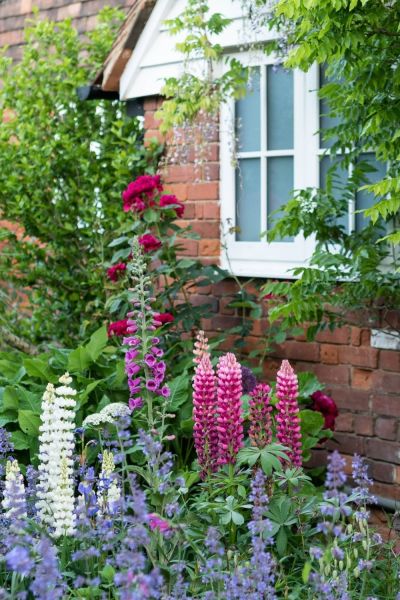
This cottage garden belongs to Sue Oriel who grows flowers to sell in the rest of her garden. Her company, Country Lane Flowers takes orders and also sells from a roadside stall in Kent, ME13 9QR.
The key elements of cottage garden style is lots of flowers, often mixed with grow-your-own veg and a fruit tree. Add in somewhere to sit, read or work. Garden furniture in a cottage garden doesn’t need to match. And there isn’t a particular style of chair, table or bench. It’s just whatever you’ve managed to acquire.
As cottage gardens are often small, they have no lawn, just paths, a courtyard and lots of flowers. But it’s a style that refuses to obey rules. So you can have lots of what you love in your garden.
There’s more about cottage garden style and how to achieve it here.
Even if you don’t live in a cottage and have a very different climate to the UK, you can still adapt cottage garden style to your own garden. Bill Bampton of the Diggers Club, Australia, calls this ‘cottage garden mashup’ here and explains how to do it.
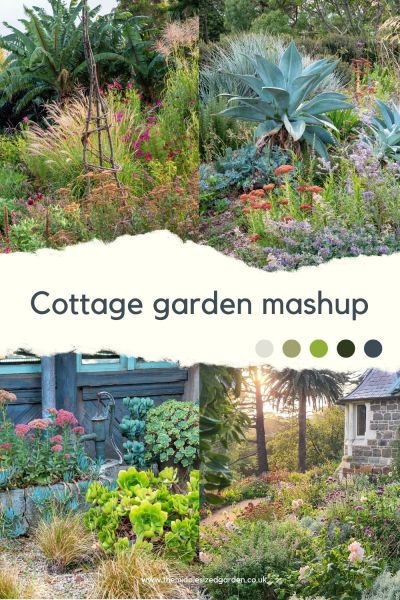
The cottage garden mashup – cottage garden style using your own local plants.
You can achieve cottage garden style even on a tight budget. There are more ideas on how to save money on garden design here.
Traditional gardens
Traditional and formal gardens aren’t quite the same, but they’re both structured. Even if they are small or middle-sized, they’re usually divided into ‘garden rooms’ with hedges, walls or trellis, each with its own style or function. The practical parts of the garden – for example, veg growing – will be separate from flower growing.
Traditional gardens will have a lawn, a herbaceous border or borders. They are filled with perennials and annuals, with plants planted in three, fives and sevens, or in swathes. Colour schemes and plant combinations are often quite carefully planned.
They’ll also have trees, shrubs, paths, terraces, a focal point – such as sculpture or a sundial – plus sheds or a greenhouse. I particularly liked the traditional garden at the Bath Priory Hotel when I visited in the autumn.
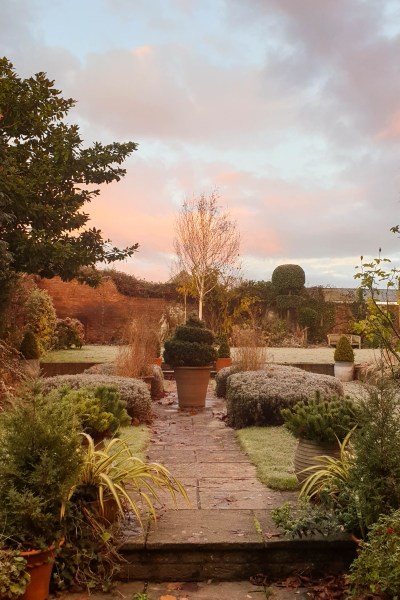
I would describe the Middlesized Garden as a ‘traditional garden’ because it has a formal parterre near the house, an open lawn at the back and a separate veg growing area out of sight of the house.
You could argue that ‘traditional garden’ isn’t a garden style, because it overlaps with ‘formal garden’ and ‘English country garden.’
Formal garden style
A traditional garden may well have a formal garden as one of its garden rooms. Formal gardens are geometric and structure. They are descended from the great gardens of Europe, such as Versailles.
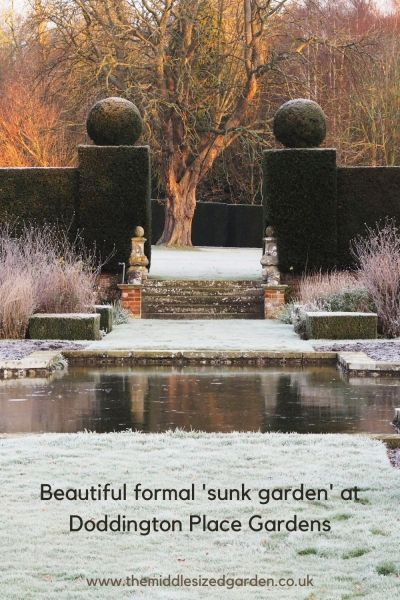
A formal pond, steps and topiary at Doddington Place Gardens, Kent.
You’ll see topiary, mazes and knot gardens in formal gardens, along with statues or sculpture. That all sounds very grand, but formality can work very well in a small space, too. Versailles might have dozens of topiary-lined avenues. A small town garden might just have one topiary-lined path. The best book on Creating Small Formal Gardens is by Roy Strong.
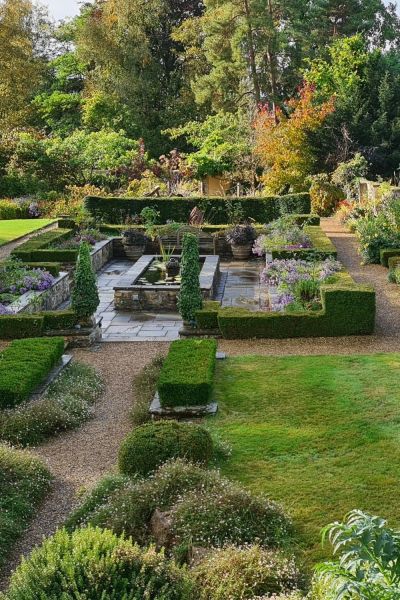
The formal sunk garden at The Bath Priory Hotel., with its raised rectangular pond and geometric topiary shapes.
Some gardens have formal elements in them. Rob and Diane Perry have created a formal use of repetition in their garden with simple topiary shapes. This gives them great winter structure.
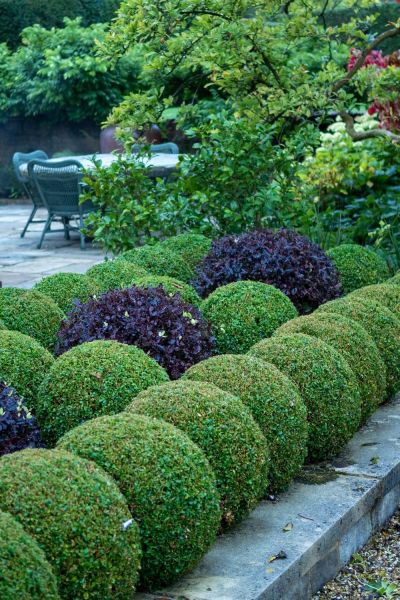
A very stylish and contemporary formal use of box and pittosporum in a beautiful Kent garden.
And this beautiful garden in the Kent countryside makes a great use of formal elements to frame a Georgian house. The structure comes from an elegant use of box and yew, both very popular for formal gardens. And as box now has a tendency to suffer from box blight and box tree caterpillar, this garden also showcases some excellent alternatives to box for topiary.
Some contemporary town gardens have a formal structure to them, so formal doesn’t have to mean historic. It’s about geometry and balance.
English country garden
English country garden style combines elements of traditional and formal garden style. It has evolved from grand or large gardens, but adapts to a middle-sized framework very well. I asked a number of experts, such as the editor of the English Garden magazine and head gardeners in English country gardens, for their definition of English country garden style.
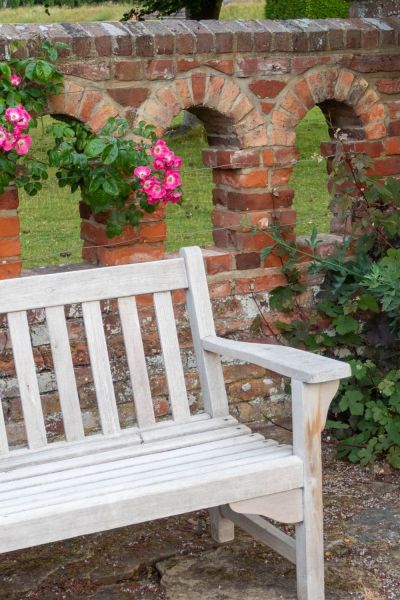
English country style includes traditional benches and garden furniture, beautiful old brickwork and roses tumbling over an arch at Doddington Place Gardens.
They said that even if you have a small garden, ‘English country’ means wide paths and deep herbaceous borders, topiary and shrubs for winter interest, a lawn or lawns, traditional garden furniture, roses, urns, a sundial and trellis. Find out more about what they say in English country garden style – what it is and how to achieve it.
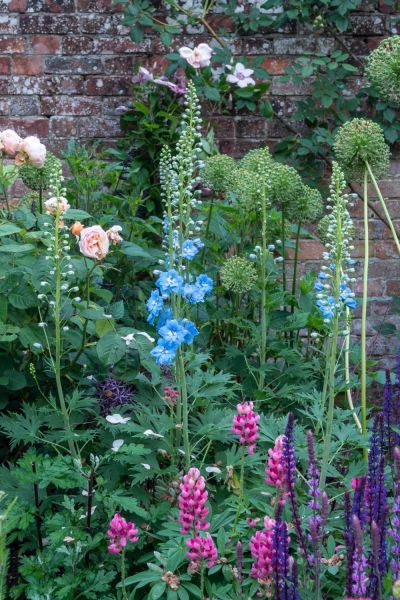
Even if you have a small garden, you can create an English country feel with deep herbaceous borders filled with perennials, such as delphiniums and lupins.
A garden style that reflects the architecture of your house
A garden design that echoes the style of your house is a harmonious look.
It’s unlikely that you’ll want to make your planting echo the style of your house, because we have so many more plants available now than we used to. If you limited yourself to Victorian plantings because you live in a Victorian house, then you’ll feel quite limited.
But it works very well to start with the architecture of your house when you’re thinking about hard landscaping. If, for example, you have a yellow brick house, you can use yellow brick for the paths. Or if your house is Edwardian, use Edwardian garden furniture.
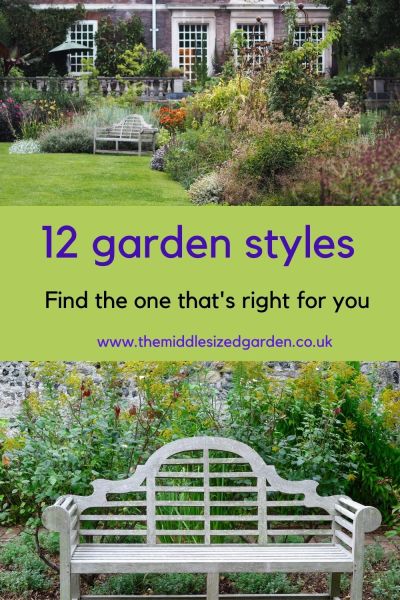
This house and garden were both designed by the famous Edwardian architect Edwin Lutyens. He also designed the famous Lutyens garden bench, which suits the house perfectly.
A brilliant example of a garden that echoes the architecture of the house is the garden at The Salutation, a former hotel. Both house and garden were designed by the famous architect Edwin Lutyens. You can see the paths are of the same brick. And Lutyens designed a famous garden bench, which can be seen all over the garden. If, for example, you live in a 1960s house, you could focus on mid century modern garden furniture styles.
And writer Francine Raymond echoes her house in her garden design in a contemporary way. She bases her garden colour theme on the yellow brick and grey slate of her house walls and roof. She even paints the furniture and pots in this signature yellow and grey, which makes mis-matched furniture and chain store pots look stylish. See Francine’s garden style tips here.
A garden can also echo the town it’s in. This ‘garden with a sense of place’ reflects the house’s history and that of Margate, as well as its owner’s tastes.
If your house seems to lack a particular style, Polly Wilkinson of Pollyanna Wilkinson Garden Design recommends linking materials and colours between inside and out. For example, if the kitchen opens onto the garden, link the kitchen floor and the outdoor hard landscaping materials in some way.
The ‘outdoor room’ – urban garden style
The garden as an outdoor room has become very popular for small gardens in towns and cities. This puts hard landscaping and garden furniture at the front of the list, although many outdoor room gardens also have good planting.
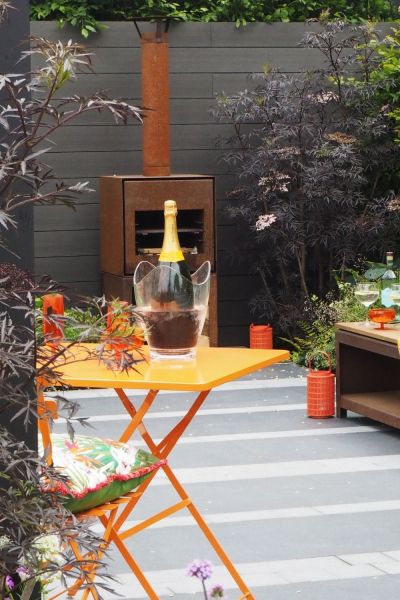
The garden as an outdoor room. This one by Martyn Wilson at BBC Gardeners World Live has a fireplace/stove and an uplifting colour scheme.
For example, you can double up raised beds and seating, as designer Charlotte Rowe does in her own garden. The broad white stone edges to her raised beds are just the right height for guests to perch on for a party. She also has a fireplace and bench seating that doubles up as storage. Every inch of space is used beautifully. See Charlotte’s 12 tips for a creative urban garden here.
Think about outdoor kitchens, gyms and even outdoor showers. Here are tips for creating an outdoor kitchen from The Frustrated Gardener blogger, Dan Cooper. Dan is a passionate plant lover and his courtyard garden is crammed with exotic plants, which shows that you can have lots of wonderful plants and a garden room you can live in.
Contemporary or modern garden style
If you like contemporary design in your home, then you’ll probably enjoy it in your garden too. Contemporary garden design has come to mean an innovative use of materials – such as corten steel and gabions. These are combined with geometric or assymetrical squares, circles and rectangles. Ponds, paths, pergolas and pots are also geometric.
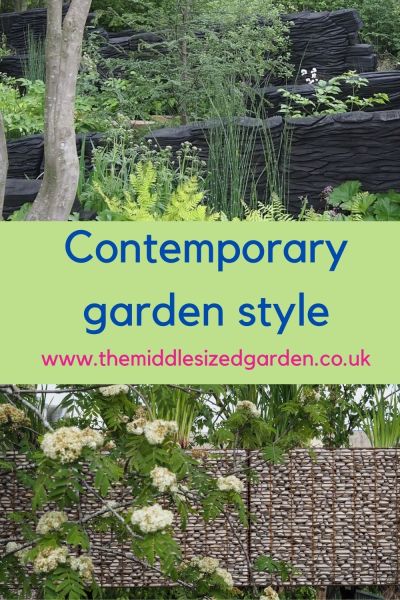
Contemporary garden styles have an innovative use of materials, such as the slate used in the top photo of Andy Sturgeon’s Best in Show garden at RHS Chelsea 2019. The photo below it is of gabions, which were originally for heavy duty landscaping.
Contemporary garden planting is carefully planned and controlled. In a small garden, a top garden designer may work with a palette of only 12-20 different plants, but they will be carefully chosen. There may be lush foliage, but you won’t see the riot of colour that you’d expect in a cottage garden. The flower colour scheme may be based on green and white, or it may feature just one or two colours.
You can see contemporary garden design at the garden shows. Not every show garden is a contemporary design, but you’ll see a good range. The RHS Chelsea Flower is the top international garden show for innovative garden design. Even if you can’t visit it, check out the coverage.
See here for a contemporary garden that uses gabions and modern furniture.
Mediterranean or ‘dry’ garden style
If you live in an area of low rainfall, then a ‘dry’ garden is an excellent choice. These can be called ‘Mediterranean gardens’, ‘Australian gardens’ or ‘desert gardens.’ The plants are at the heart of this style. Look for drought tolerant and drought resistant plants. These include succulents, cacti and several ornamental grasses. Good dry garden perennials and herbs include rosemary, lavender and verbascum.
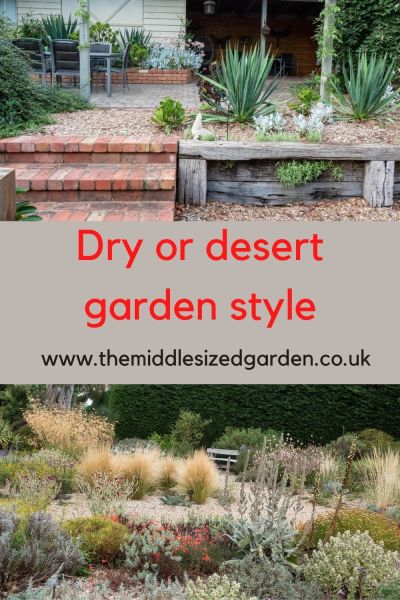
Dry or desert garden style starts with drought-resistant plantings. No lawns though, because they need watering.
There’s more in this post about how to create a dry garden, based on advice from the Beth Chatto Gardens in Essex. Although annual rainfall is only around 20″ a year, Beth Chatto created a garden that never needed watering.
A dry garden will usually have a gravel mulch, which helps stop the earth from drying out. It also allows plants to spread and self-seed easily, although the flip side of that is that it needs regular weeding. But you’ve saved all that time by not watering!
Dry or desert gardens also have pots and sculpture. But they don’t always have specific paths, as plants grow directly out of the rock and gravel. For more inspiration see this beautiful private Australian garden with some dry planting. Or see 7 garden design ideas from four private gardens for an Australian sculpture garden.
Warning! If you live in an area of heavy rainfall, this is not the look for you.
A coastal garden theme
This is very similar to a dry garden. You need drought-tolerant plants which also withstand windy conditions. If you live directly on the sea, you’ll need plants that can cope with salt spray, too. But if you live a few streets back, that’s unlikely to be a problem. Find out which plants are good for a coastal garden here.
In a coastal garden, you’ll also plant into gravel, shingle or sand. Wooden decking is good for this look. The coastal garden look doesn’t have a lawn.
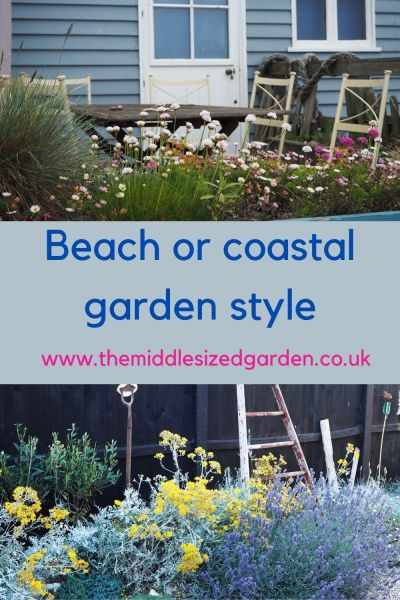
Beach garden style features wind or drought-resistant planting and recycled furniture and ornaments.
And garden furniture and ornaments often have a seaside theme. Or they’ll be recycled or upcycled ‘found’ objects or made of driftwood. Almost anything can wash up on a beach, battered and faded, to be re-used in a coastal garden.
I live near Whitstable, on the Kent coast. Whitstable has some delightful seaside gardens. See them here in how to create a delightful seaside garden.
Exotic ‘jungle’ garden style
This is another garden style which puts plants at its heart. Think tree ferns, banana palms, brilliant colours and large leaves, planted densely. There are a surprising number of tropical-looking plants which do well in cooler, temperate climates. But some of the plants, such as cannas, dahlias and palms, may need special care in the winter.
Philip Oostenbrink is Head Gardener at Walmer Castle, where he’s creating a jungle-style garden in the moat. And he also has a small jungle garden behind his own house, so it’s a style that works well in both small and big gardens. Read Philip’s advice on creating a jungle garden here.

Go for brightly coloured flowers and plants with exciting leaf shapes and colours in an exotic garden. This look relies on lots of plants and layering.
Award-winning head gardener, Steven Edney and his partner Lou Dowle have a tropical garden in their own Kent home. Steve says that it’s a style that ‘needs a greenhouse’ because some of the plants are tender.
Crowd your plants up, using every inch of planting space you have. Exotic gardens have paths and a seating area, sheltered from the sun by trees. But forget about lawns.
See this post on how to create a brilliant exotic garden in a cool climate.
A wildlife garden
This doesn’t have to be a garden style as such. A traditional or formal garden can be very wildlife friendly, if the gardeners don’t use chemicals. When I visited Paul and Frances Moskovits’s garden with its amazing herbaceous border, I was almost deafened by the birdsong. And Frances says that the birds and frogs clean up slugs and snails for her.
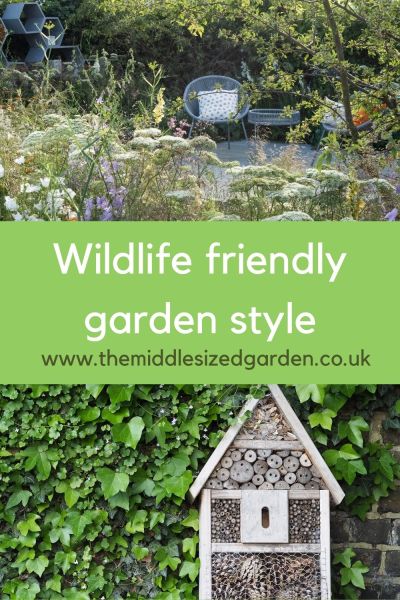
Wildlife gardens can be any style. They need food, water and shelter, plus no or a very low use of chemical sprays.
Most of the gardens I’ve featured on the Middlesized Garden are very wildlife-friendly, such as the rose garden at Hever Castle, the amazingly beautiful English country gardens at Gravetye Manor Hotel and the Beth Chatto gardens. Yet they’re all very different styles of garden.
But if you want to put wildlife and the environment first above everything, then it’s essential to provide food, water and shelter.
Choose pollinator friendly planting and plants that have seeds and berries. You need at least one source of water and some shelter. This can be as simple as leaving piles of leaves and garden clippings in corners. Or you can make or buy bug hotels, bat boxes and bird boxes.
It’s also important to minimise your use of chemicals and to look after your soil. In this post, award winning garden designer Fern Alder explains that there are more living organisms and micro-organisms in one teaspoon of soil than there are people on earth. So one of her top wildlife friendly tips is to add garden compost, well rotted manure or another mulch to your soil at least once a year. This feeds those micro-organisms and helps keep your soil healthy and alive.
There’s a post here on what a wildlife garden really needs.
A Japanese garden
Japanese garden style is about balance. It’s a carefully curated vision of the natural world. Instead of a riot of colour, there are carefully planned features, often balanced with empty space so that you can appreciate them. Instead of several trees or shrubs, a Japanese garden may have just one or two beautifully pruned specimens.
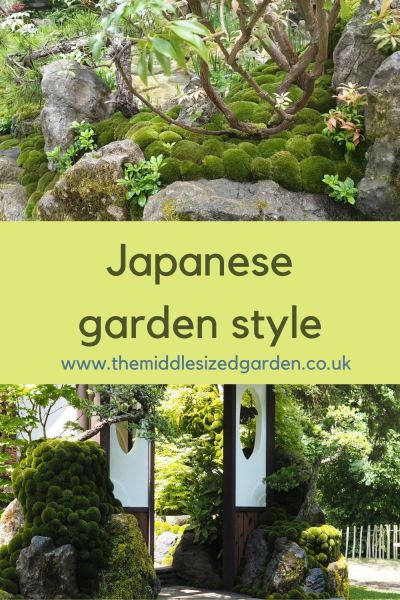
Kazuyuki Ishihara is a Japanese garden designer who has won many awards at RHS Chelsea Flower Show. Japanese garden design is carefully thought out, with beautiful pruning and a use of texture through mosses, stone and lichens.
Ikebana or Japanese flower arranging also impacts on planting in gardens. It’s an asymmetrical triangle. You plant or arrange flowers based on the three principles of heaven, earth and humanity. A tall plant reaches up to heaven, a low growing one covers the earth and in between there is the plant that represents humanity. Beth Chatto used ikebana as a basis for her dry garden planting.
Correct pruning is another big feature of Japanese gardens.
And there’s an interesting use of materials, such as moss. The key is to use a simple colour palette, with contrasting shades of green and perhaps just one signature colour, such as red, white or pink.
Texture is important in a Japanese garden too. If stones or garden ornaments age with lichens, leave them. Don’t scrub them off. The patina of age is part of the garden experience. (Although do scrub off anything slippery underfoot!)
Japanese gardens also have water features, such as ponds and waterfalls. These, too, will be carefully designed and balanced within the garden as a whole.
There’ll be an Asian theme to sheds, pergolas and garden furniture, too, of course. But you can’t create a ‘Japanese garden’ simply by filling a Western garden with Japanese or Asian themed furniture and objects.
Find out more in Monty Don’s book Japanese gardens – a journey. His thoughtful and knowledgeable commentary is always illuminating. Note that links to Amazon are affiliate, which means that I may get a small fee if you buy, but it won’t affect the price you pay.
Bonus garden style suggestions
Here are 10 more garden style ideas plus 7 garden design ideas from private gardens.
If your garden is sloping, then a rock garden can be a stunning option.
Shop my favourite garden tools, products and books
I’m often asked for recommendations so I’ve put together lists of the gardening books, tools and products that I use, or which have been recommended to me, on the Middlesized Garden Amazon store. For example, there’s a list of essential garden tools and also of my favourite books on gardening.
More of each garden style in the video:
Pin to remember 12 garden styles
And sign up here for a weekly catch-up of garden tips, ideas and inspiration from the Middlesized Garden.
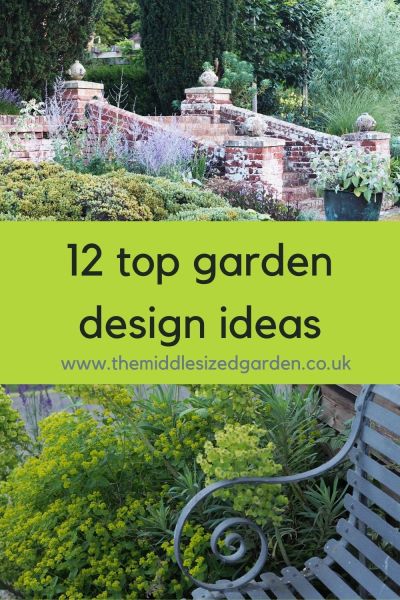
























Wildlife garden every time for me. With our growing towns and cities, there is becoming less and less space for our struggling wildlife. The more safe sanctuary we can create the better even a small pond will attract so much wildlife to your garden and trees and bushes for the birds is a great start.
You hit the nail on this blog. My gardens cross of say Hidcote but softened by planting. I think perhaps cross with Wollerton old hall with a William Robinson type lawn in centre with folly .Did i plan it all .Yes but admit to little changes as i Built it. 6 years and now looking good.Brick oven to build this year and English garden party soon after in June
That sounds lovely!
very nice
thank you!
I do love your blog! Reading through though, I noticed you have missed two gardening styles. One describes my own, which is eclectic – much like inside my home. The other is the woodland garden and arent’t they beautiful!
Thank you and you are quite right – a number of people have mentioned both eclectic and woodland so I will add them into the post.